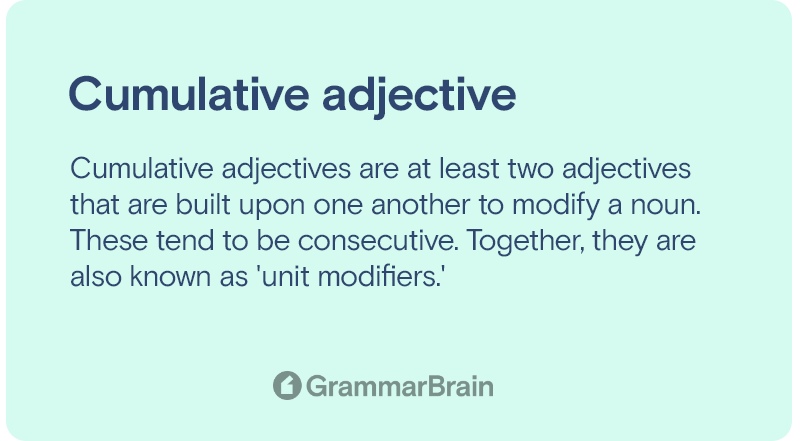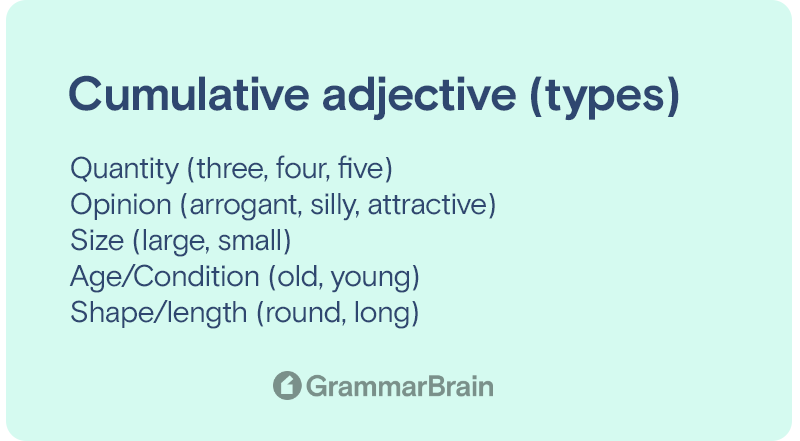What is a cumulative adjective? How is it different from a regular adjective? And what are the grammar rules that follow it? These are all great questions when it comes to understanding the various types of adjectives in the English language. Let’s jump in and learn about these forms.

What are Cumulative Adjectives?
Cumulative adjectives are at least two adjectives that are built upon one another to modify a noun. These tend to be consecutive. Together, they are also known as ‘unit modifiers.’ Cumulative adjectives tend to work together to modify nouns and don’t independently describe nouns.
For example, consider the sentence – ‘look at this dark black spider.’ In this sentence, the words ‘dark’ and ‘black’ are used to describe the ‘spider.’ The use of color adjectives is made even more precise by the addition of the word ‘this.’ The sentence is talking about a specific spider that is dark and black.
With cumulative adjectives, you’re building up meaning the closer you get to the noun. If the order of the cumulative adjectives is changed, it can destroy the sentence’s meaning.

How are Cumulative Adjectives Formed?
There is a particular order that you need to follow when it comes to cumulative adjectives. The closer you get to the noun in your sentence, the more terms you use to describe the noun will be more specific. Generally, cumulative adjectives need to appear in a certain order. This is as follows:
- Quantity (three, four, five)
- Opinion (arrogant, silly, attractive)
- Size (large, small)
- Age/Condition (old, young)
- Shape/length (round, long)
- Color (green, yellow)
- Origin/Region/Nationality (Christian, Muslim)
- Material (plastic, wood)
- Purpose (living room)
Cumulative adjectives need to be used together while following a specific order. A sentence example would be, ‘Kim bought a flashy new blue car last week.’ Here, the opinion, age, and color adjectives are placed next to each other in order to form a cumulative adjective.

Types of Adjectives and Cumulative Adjective Examples
Now that you know what cumulative adjectives are, let’s look at a few examples.
Example 1: Two huge French cricketers saved the woman from gangsters.
In this sentence, ‘two’, ‘huge’, and ‘ French’ are used to modify the noun ‘cricketers.’ Should you reverse the order in which the cumulative adjectives are written, the sentence won’t make sense anymore.
Example 2: I purchased a new red sleeping bag to use for camping.
Here, the terms ‘new’, ‘red,’ and ‘sleeping’ are used to define the word ‘bag,’ which is a noun. Once again, if you reverse the order in which the adjectives are written in, the sentence won’t make sense anymore.
Now that you know about ordering cumulative adjectives, let’s look at how they compare against regular adjectives.
Cumulative Adjectives vs Regular Adjectives
The cumulative adjectives definition says that two or more adjectives need to be used to define a noun for those adjectives to be considered cumulative adjectives. In general, there are four kinds of adjectives. These include:
- Possessive Adjectives: Represents the possession of a certain quality.
- Interrogative Adjectives: Modifies a noun or pronoun by asking questions.
- Demonstrative Adjectives: Used to describe the position that a subject has, either in space or time.
- Compound Adjectives: When at least two adjectives come together to modify the subject, it’s called a compound adjective.
You can use just one adjective to describe a noun. However, this will no longer be considered a cumulative adjective. To use cumulative adjectives, you’ll need to use at least two adjectives to describe your noun or pronoun. These adjectives also need to be in a specific order, which helps the sentence make sense.
Another question people often have about cumulative adjectives is how they differ from coordinate adjectives. Usually, coordinate adjectives will be separated by a comma, and cumulative adjectives aren’t.
Key Differences
When you use cumulative adjectives in your sentence, you’ll use adjectives from different categories, such as age, size, color, and so on. It’s also considered a cumulative adjective when the final adjective placed before the noun creates a compound noun. This especially applies to specifying origins. You can’t add commas or the word ‘and’ between two cumulative adjectives.
However, with coordinate adjectives, you can. The critical difference between cumulative objectives and other adjectives is that there’s a specific order to using cumulative adjectives. Also, note that there aren’t any commas or conjunctions between each adjective.
Cumulative Adjectives Sentence Examples
Now let’s look at some examples of cumulative adjectives.
1. A large rectangular blue box. Here, the words ‘large’, ‘rectangular,’ and ‘blue’ are used to describe the box.
2. A new American electric car. In this sentence, the words ‘new’, ‘American’, and ‘electric’, describe what kind of a car it is.
3. An attractive young American lady. Again, you can learn what kind of a lady she is through the use of the adjectives ‘attractive’, ‘young’, and ‘American’.
FAQs
How Do You Identify Cumulative Adjectives?
Anytime the adjectives used to belong to different categories and also follow a specific order, they are considered cumulative adjectives. Also, you cannot switch the places of cumulative adjectives without affecting the sentence’s meaning.
What Are The Order Of Cumulative Adjectives?
The order that cumulative adjectives appear in is as follows – quantity, opinion, size, age, color, shape, origin, material, and finally, purpose.
Is Color A Cumulative Adjective?
Yes, color is considered a cumulative adjective, as it can work together with other adjectives to describe a noun.
Define Cumulative Adjectives
Cumulative adjectives are two or more adjectives that are used to modify a noun.
Inside this article
Fact checked:
Content is rigorously reviewed by a team of qualified and experienced fact checkers. Fact checkers review articles for factual accuracy, relevance, and timeliness. Learn more.
Core lessons
Glossary
- Abstract Noun
- Accusative Case
- Anecdote
- Antonym
- Active Sentence
- Adverb
- Adjective
- Allegory
- Alliteration
- Adjective Clause
- Adjective Phrase
- Ampersand
- Anastrophe
- Adverbial Clause
- Appositive Phrase
- Clause
- Compound Adjective
- Complex Sentence
- Compound Words
- Compound Predicate
- Common Noun
- Comparative Adjective
- Comparative and Superlative
- Compound Noun
- Compound Subject
- Compound Sentence
- Copular Verb
- Collective Noun
- Colloquialism
- Conciseness
- Consonance
- Conditional
- Concrete Noun
- Conjunction
- Conjugation
- Conditional Sentence
- Comma Splice
- Correlative Conjunction
- Coordinating Conjunction
- Coordinate Adjective
- Cumulative Adjective
- Dative Case
- Determiner
- Declarative Sentence
- Declarative Statement
- Direct Object Pronoun
- Direct Object
- Diction
- Diphthong
- Dangling Modifier
- Demonstrative Pronoun
- Demonstrative Adjective
- Direct Characterization
- Definite Article
- Doublespeak
- False Dilemma Fallacy
- Future Perfect Progressive
- Future Simple
- Future Perfect Continuous
- Future Perfect
- First Conditional
- Irregular Adjective
- Irregular Verb
- Imperative Sentence
- Indefinite Article
- Intransitive Verb
- Introductory Phrase
- Indefinite Pronoun
- Indirect Characterization
- Interrogative Sentence
- Intensive Pronoun
- Inanimate Object
- Indefinite Tense
- Infinitive Phrase
- Interjection
- Intensifier
- Infinitive
- Indicative Mood
- Participle
- Parallelism
- Prepositional Phrase
- Past Simple Tense
- Past Continuous Tense
- Past Perfect Tense
- Past Progressive Tense
- Present Simple Tense
- Present Perfect Tense
- Personal Pronoun
- Personification
- Persuasive Writing
- Parallel Structure
- Phrasal Verb
- Predicate Adjective
- Predicate Nominative
- Phonetic Language
- Plural Noun
- Punctuation
- Punctuation Marks
- Preposition
- Preposition of Place
- Parts of Speech
- Possessive Adjective
- Possessive Determiner
- Possessive Case
- Possessive Noun
- Proper Adjective
- Proper Noun
- Present Participle
- Prefix
- Predicate



